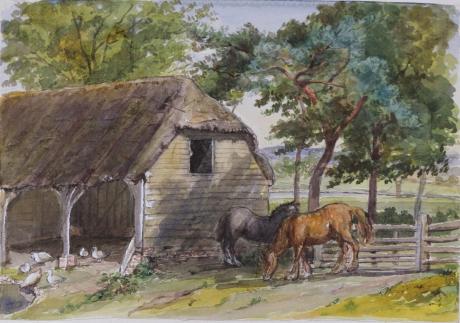inscribed and dated "Farmyard Aston Bampton Oxfordshire wed sept 11 1861" and signed with initials "LWT"
Tom and Laura Taylor and thence by descent
Aston is a village about 4 miles (6.4 km) south of Witney in West Oxfordshire, England. The village is part of the civil parish of Aston, Cote, Shifford and Chimney. The southern boundary of the parish is the River Thames. The 2011 Census recorded the parish's population as 1,374.
Until the 19th century Aston was a township in the ancient parish of Bampton. In 1866 the civil parish of Aston and Cote was separated from Bampton. In 1931 Aston and Cote was united with Chimney to form the civil parish of Aston Bampton, which was merged with Shifford in 1954 to form the parish of Aston Bampton and Shifford. The parish was later renamed Aston, Cote, Shifford and Chimney.
The Church of England parish church of Saint James was built in 1839 with only a low squat tower and one bell. Later a spire and second bell were added. The Gothic Revival architect Joseph Clarke restored the building in 1862, even though it was only 23 years old at the time. The architect HGW Drinkwater made further alterations in 1885–89.The present ring of six bells was cast by John Taylor & Co. of Loughborough in 1883, the two original bells being taken in part exchange. Two brass plates in the church commemorate the names of local clergy and churchwardens at the time of the bells' dedication and benefactors who contributed to the cost, the balance of which was raised by public subscription. In 1992 the bells were restored and re-hung by White's of Appleton following two years of local fund-raising. In 1857 Aston, Cote and Shifford were made part of the ecclesiastical parish of Bampton Aston. It now forms part of the benefice of Bampton with Clanfield, which also includes the parish of Lew.
Laura Wilson Barker (6 March 1819 – 22 May 1905), was a composer, performer and artist, sometimes also referred to as Laura Barker, Laura W Taylor or "Mrs Tom Taylor".
She was born in Thirkleby, North Yorkshire, third daughter of a clergyman, the Rev. Thomas Barker. She studied privately with Cipriani Potter and became an accomplished pianist and violinist. As a young girl Barker performed with both Louis Spohr and Paganini. She began composing in the mid-1830s - her Seven Romances for voice and guitar were published in 1837. From around 1843 until 1855 she taught music at York School for the Blind. During this period some of her compositions - including a symphony in manuscript, on 19 April 1845 - were performed at York Choral Society concerts.
On 19 June 1855 she married the English dramatist, critic, biographer, public servant, and editor of Punch magazine Tom Taylor. Barker contributed music to at least one of her husband's plays, an overture and entr'acte to Joan of Arc (1871), and provided harmonisations as an appendix to his translation of Ballads and Songs of Brittany (1865).
Her other works include the cantata Enone (1850), the violin sonata A Country Walk (1860), theatre music for As You Like It, (April 1880), Songs of Youth (1884), string quartets, madrigals and solo songs. Her choral setting of Keats's A Prophecy, composed in 1850, was performed for the first time 49 years later at the Hovingham Festival in 1899. The composer was present.
Several of Barker's paintings hang at Smallhythe Place in Kent, Ellen Terry's house.
Barker lived with her husband and family at 84 Lavender Sweep, Battersea. There were two children: the artist John Wycliffe Taylor (1859–1925), and Laura Lucy Arnold Taylor (1863–1940). The Sunday musical soirees at the house attracted many well-known attendees, including Lewis Carroll, Charles Dickens, Henry Irving, Charles Reade, Alfred Tennyson, Ellen Terry and William Makepeace Thackeray.
Tom Taylor died suddenly at his home in 1880 at the age of 62. After his death, his widow retired to Porch House, Coleshill in Buckinghamshire, where she died on 22 May 1905, aged 86.

